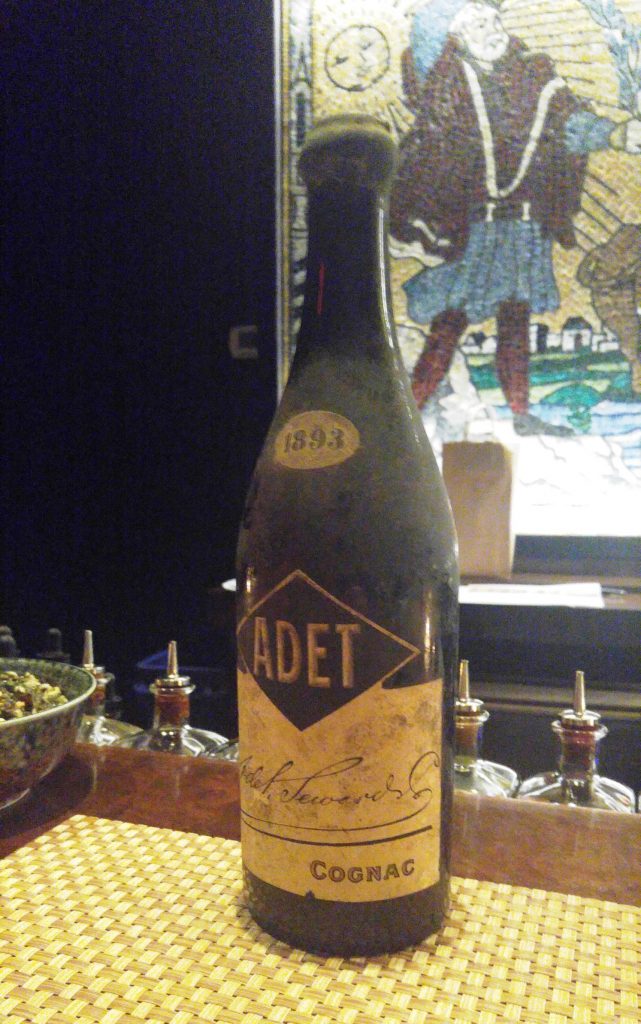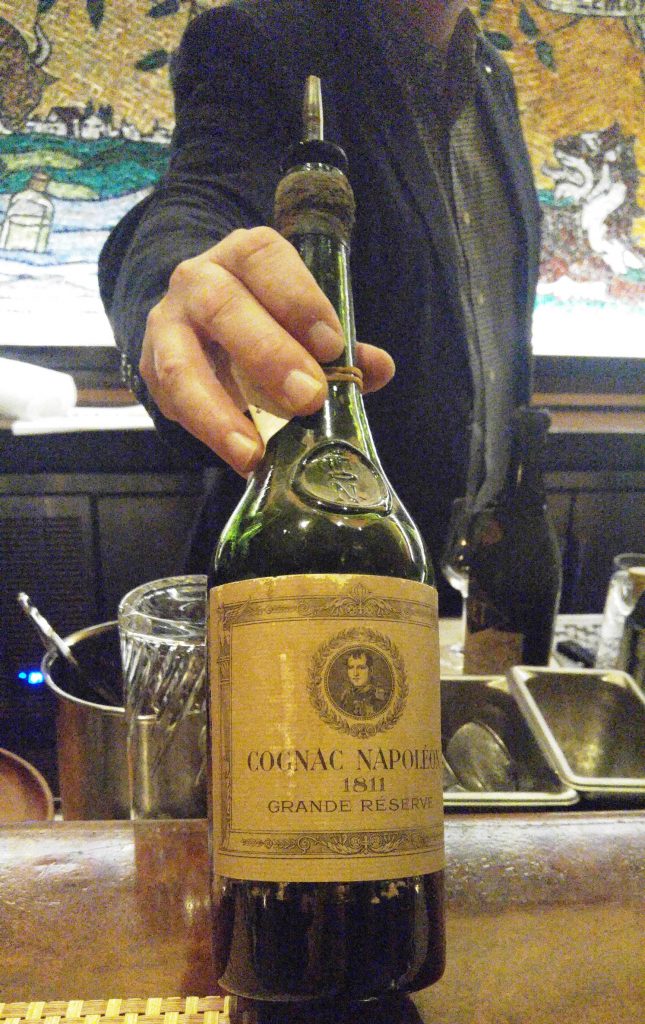Should You Drink Old Liquor?
All photos by Jake Emen.
"It's history in a bottle," reflects Bart Laming, managing director of Old Liquors, a Netherlands-based collector and purveyor of vintage spirits. "How often do you get to do that?"
Laming is in Washington, D.C., hosting a stupidly splendid vintage spirits tasting, showcasing some of his wares. Originally tasked with selling a private collection of 7,000 bottles, the oldest of which dates to 1760, Old Liquors is now a full-time and ongoing operation, both buying and selling beyond that initial stash.
Over two nights at the Columbia Room, Laming pours eleven bottles, eight of which I manage to personally try on the event's first night. "I was trying to think of when I've seen an event like this... and I haven't," said Derek Brown, Columbia Room's chief.
"This is one of the rare occasions when we ever open a bottle," adds Laming. "We're not in the business of opening bottles." Yes, we all know quite how lucky we are to be in the midst of this tasting right now.
The full show-stopping lineup:
1811 Napoleon Cognac
1834 Madeira Barbeito
1865 Madeira Café Anglais
1870 Chateau Peyrouet Armagnac*
1887 Port, no label, unknown brand, two bottles*
1893 Adet Seward Cognac
1893 Jacques Marou Armagnac
1914 Maxim's Cognac
1914 Chateau Paulet Cognac*
1928 Croizet B. Leon Cognac
*(Did not taste; tasted one of two 1887 Ports).
Make no mistake, the majority of these were wonderful. But it's not the tasting profile you're clamoring for, it's the transportive effect of moving back through the decades and centuries that makes vintage spirits worth trying, and for the financially inclined, hoarding.
Consider that two bottles of 1780 Rémy Martin Cognac are currently listed at Laming's website for €97,880 (about $122,084) apiece. Good thing nothing at this event was that crazy, with the oldest bottle only stretching to 1811. That's the Cognac 1811 Napoleon Grand Reserve, of which the Columbia Room happens to have their own bottle ready and waiting as part of the bar's vintage collection. They charge $475 for a half ounce pour of the stuff.
The year is no accident, either. "You see a lot of 1811 Cognacs," says Laming. "It's one of the special years of Cognac."
A comet, known as The Great Comet of 1811, was visible to the naked eye for 260 days, serving as an omen and a sign. How was it taken in the Cognac industry? "The harvest was influenced by the gods," says Laming.
Further, Napoleon's son, dubbed the King of Rome, was born in 1811. During the same year, Napoleon himself visited the Courvoisier warehouse in Bercy, and began providing a morning ration of Cognac to his troops.
So, again, surviving bottles of 1811 Napoleon Cognac are no fluke, and it's that type of story which adds mystique to the world of the super vintage. "It's all stories," says Laming.
Tasting Vintage Spirits
"The interesting thing about an old bottle of Cognac is that you never know how it's going to taste until you open it," says Laming. Beyond not knowing what the bottle has been through over the centuries and the sanctity or not of its storage, you may know a vintage date, but not know how long the spirit was actually aged for, and to what capacity. "You can never be an expert on spirits this old," he says, because everything is always going to be different.
Further, there's the chance that the spirit inside is no longer at its best, price and rarity be damned. "If there's a foul smelling bottle tonight when it's opened, that's part of the game," says Laming, although he adds that rarely happens for properly vetted bottles in their collection.
Still, one of the bottles, the 1887 Port, gave off a semi-sour and vinegary aroma. It opened up more on the palate, its taste improving upon its nose, and delivering raw clover honey amongst a portfolio of sour and tart notes, along with touches of smoky meats — smoked ham hocks came to mind for me, beef jerky to others — as well as touches of rosemary and light pine needle notes.
But as Laming says, it's part of the game, and in some way — once again as long as you have the funds to do so — it only adds to the overall experience. There's a risk to buying and opening a super vintage bottle. But that makes each payoff, a beautiful pour from a secret stash, a sip slowly savored which delivers complex flavors 200 years or more after its creation, like a payoff of a huge gamble.
Buying and tasting vintage spirits also offers the further experience of planning... When will I open this bottle? With whom? What will the occasion be? All of this heightens the drama and anticipation, adding to the overall glow of the tasting itself.
As for the above bottles I tried, the 1834 Madeira Barbeito drew the biggest response from the crowd. It offered a huge wow factor, with its palate showcasing rich red fruits and sweetness, but its nose showing a savory, grassy and herbal side, almost akin to a lusciously reduced red wine sauce.
Fact Checking Your Vintage Spirits, and Serving Them
A key piece to the vintage spirits puzzle is of course being able to accurately identify fraud from fact. Laming has honed numerous tools along the way. Here are a few tips:
Fill Lines: Too-low levels indicate leakage, and likely spoiled contents within. Too high, and you're looking at something that was likely refilled and rewaxed. "You don't see very old bottles with high fill levels," says Laming. "If it's too high, I'm concerned."
The Bottle: "You also look at the bottle shape," says Laming. Different bottles were used at specific times by particular brands, with no ifs, ands, or buts about it. Laming often also checks vintage advertisements of the projected era as a comparison.
Corks: The shape and quality of the cork, and its depth in the bottle's neck, are key.
Provenance: "We try to build the provenance of it, like with art," Laming says. Who owned it, when and where? Building that timeline and lineage helps verify and legitimize a bottle.
Moving ahead to serving the stuff, the process of pouring a vintage spirit begins with exceedingly careful bottle cork removal surgery. Laming painstakingly deployed multiple gadgets before gently grasping each full cork from both sides and retrieving it intact from each bottle.
After opening a vintage bottle, Laming suggests it can be safely stored for several months with no ill effects to the spirit. If you plan on keeping it for longer than that though, then he recommends using inert gas to fill the bottle, and it can keep indefinitely. "You could easily keep these for a very long time and nothing will happen to it," he says.
As for how one is to consume such vintage spirits, neat pours are recommended, and the Madeira and Port selections above were decanted first before serving, poured over a strainer to catch sediment. But what about serving vintage spirits in cocktails? Brown pondered the question:
" It depends on if you can afford it, and if your god allows it," he says. And hey, if those two boxes are neatly checked off, then by all means. "It's always going to be delicious!"





